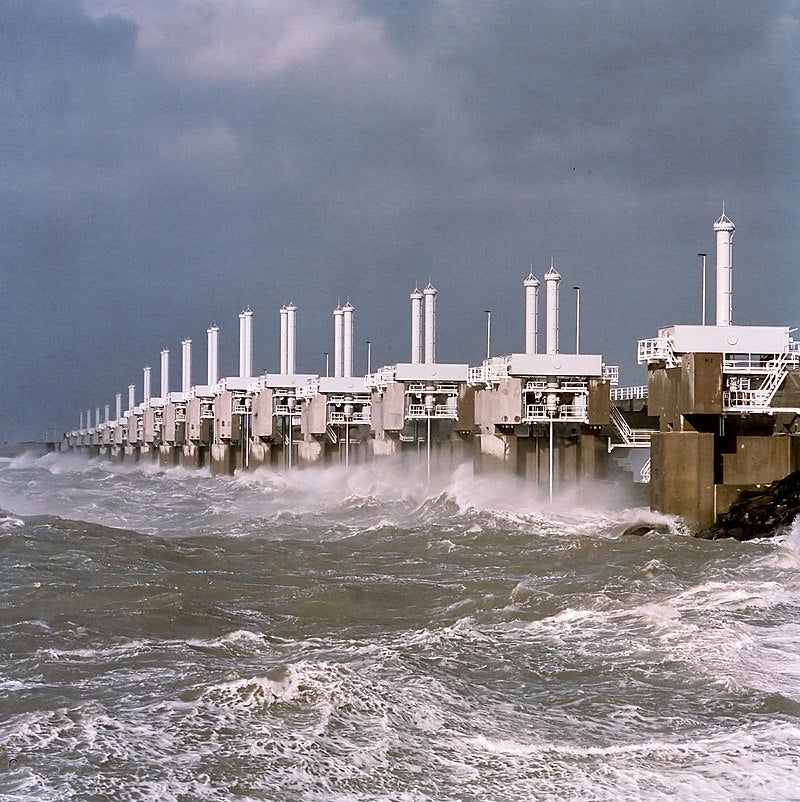By Philip Orton, Research Associate Professor, Stevens Institute of Technology
Due to the increasing frequency and risk of coastal storms and flood disasters, many governments and decision makers are looking to construct gated storm surge barriers.
The U.S. Army Corps of Engineers is recommending these large steel and concrete barriers be built across entrances to 11 U.S. estuaries, enabling closure during storm surges to minimize coastal flooding. However, many scientists are wary of the potential effects these barriers could have on coastal ecosystems, leading many advocates to push for a precautionary approach or their outright rejection.
Published in the scientific journal Earth’s Future and supported in part by funding from Environmental Defense Fund, colleagues and I recently formulated a new research agenda focused on the intersection between the increased use of storm surge barriers and the resulting estuary impacts. These are three key takeaways from our research:
1. Storm surge barriers can fundamentally change our coastlines and negatively impact estuarine ecosystems
In the last 10 years, there have been more barriers constructed compared to any other decade. And the impact of this construction has the potential to fundamentally impact nearby coastlines and ecosystems.
Surge barriers can be an efficient approach to minimize flooding, property damage and loss of life. Yet because of interfering with the flow of water in and out of an estuary, these barriers can cause major changes to saltwater intrusion, affect sediment flows and negatively impact water quality.
Changes to an estuary’s physical conditions occur both when the barriers are left open and increasingly when closed. Past experience with constructed barriers shows that these changes can affect local ecology, such as by causing long-term reductions in marsh habitat, in addition to having impacts on fish and migratory species.

Caption: Conceptual diagram showing cases (a, c) without a surge barrier, (b, d) with one, and during (a, b) calm weather, and (c, d) a severe storm surge event. Selected known effects of surge barriers are to increase water speed (blue arrows) through open gates during calm weather (comparing a to b) and reduce flooding of wetlands and populated areas during storms (comparing c to d). Some of the topics for which further research is needed are sedimentation on marshes during flooding (c, d inset circles), induced development in floodplains (increasing buildings from a to b), and effects on migrating organisms (comparing a to b). / Source: https://agupubs.onlinelibrary.wiley.com/doi/10.1029/2022EF002991.
2. Sea level rise is increasing the frequency of when barriers are used
Gate closures are typically triggered when the forecasted water levels exceed a specific threshold. But due to sea level rise, these gates are being closed more frequently than originally planned, in some cases.
These are likely to exacerbate existing problems with dissolved oxygen and salinity, as well as lead to a false sense of security that results in increased land use development in risky areas behind the barriers.
3. There is uncertainty about the long-term impacts and tradeoffs between barriers and other solutions
While gated surge barriers may seem to be a quick fix, a primary focus on these structures can take away efforts and resources invested in longer-term, integrated approaches that address multiple flood hazards and permanent inundation due to sea level rise. Unless land-based strategies such as the relocation and elevation of structures in high-risk areas, installation of berms and natural floodplain restoration are also implemented, communities will continue to be susceptible to flooding.
We need to better understand the long-term impact and true costs and benefits associated with barriers before turning to them as a major solution. Our research recommends that we first need to better understand the ecological effects and impacts on sedimentary systems, tidal wetlands, migratory species and cumulative impacts in urban estuaries (such as combined sewer overflows, dredging and development).
Additionally, the recent increasing damage associated with coastal disasters is not only associated with climate change, but also the increases in population and building in floodplains. In short, we are broadly perpetuating our relationship with risk by pursuing the solutions that focus on barrier implementation.
It is critical that these tradeoffs be better understood and that they are adequately considered in flood risk management projects.
From New York City to Venice, Italy, gated storm surge barriers are currently being constructed or proposed across the globe to combat flooding and storm surge. Past experience and our research both demonstrate that it is important to seriously consider the impacts barriers may have on our coastlines and ecosystems – and I urge decision makers to fully evaluate those impacts when creating a flood risk management plan.










